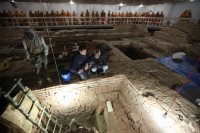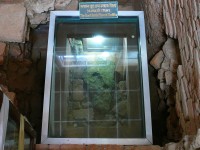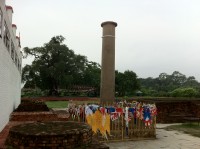 Archaeologists digging in the Maya Devi Temple in Lumbini, Nepal, have unearthed the remains of a timber structure around an open space dating back to the sixth century B.C. which would make it the earliest known Buddhist shrine.
Archaeologists digging in the Maya Devi Temple in Lumbini, Nepal, have unearthed the remains of a timber structure around an open space dating back to the sixth century B.C. which would make it the earliest known Buddhist shrine.
Tradition has it that Lumbini is where Siddhārtha Gautama was born. The Maya Devi Temple is one of four major pilgrimage sites for Buddhists today (the other three are the places of his enlightenment, first discourse, and death as identified by the Buddha in the Parinibbana Sutta) and pilgrims have been visiting the temple as the Buddha’s place of birth since at least the third century B.C. A large stone found in 1996 was installed in the third century B.C. to mark the precise spot.
Buddhist tradition records that Queen Maya Devi, the mother of the Buddha, gave birth to him while holding on to the branch of a tree within the Lumbini Garden, midway between the kingdoms of her husband and parents. Coningham and his colleagues postulate that the open space in the center of the most ancient, timber shrine may have accommodated a tree. Brick temples built later above the timber one also were arranged around the central space, which was unroofed.
To determine the dates of the timber shrine and a previously unknown early brick structure above it, fragments of charcoal and grains of sand were tested using a combination of radiocarbon and optically stimulated luminescence techniques. Geoarchaeological research has confirmed the presence of ancient tree roots within the temple’s central void.
 There is a debate about when the Buddha was born — historians have theorized anywhere between 623 BC and 340 B.C. — and until now, the earliest archaeological evidence of Buddhist temples dates to the reign of Indian Emperor Ashoka (reigned 269 B.C. to 232 B.C.), a convert to Buddhism who built stupas, monasteries and shrines all over his empire. One of them was a brick cross-wall temple at Lumbini, in fact, under whose remains the archaeological team dug to find the earlier shrine.
There is a debate about when the Buddha was born — historians have theorized anywhere between 623 BC and 340 B.C. — and until now, the earliest archaeological evidence of Buddhist temples dates to the reign of Indian Emperor Ashoka (reigned 269 B.C. to 232 B.C.), a convert to Buddhism who built stupas, monasteries and shrines all over his empire. One of them was a brick cross-wall temple at Lumbini, in fact, under whose remains the archaeological team dug to find the earlier shrine.
It was an engraved pillar erected by Ashoka that identified Lumbini after it was lost to the jungle for centuries. In 1896, German archaeologist Dr. Alois Anton Fuhrer (who was later revealed to have been a prolific forger of Buddhist relics) found a 22-foot pillar inscribed “Twenty years after his coronation, Beloved-of-the-Gods, King Piyadasi [aka Ashoka], visited this place and worshiped because here the Buddha, the sage of the Sakyans, was born. He had a stone figure and a pillar set up and because the Lord was born here, the village of Lumbini was exempted from tax and required to pay only one eighth of the produce.”
 Another inscription found higher up on the pillar where pilgrims left their marks in the centuries after Ashoka was made by King Ripu Malla in the early 14th century. Somewhere in the 15th century, the temple stopped drawing pilgrims for unknown reasons and the buildings fell into ruin. The rediscovery of the site in the late 19th century re-established it as an important pilgrimage destination and made excavating down to the earliest levels impossible until recently. Archaeologists dug inside the central temple building as monks and pilgrims prayed around them.
Another inscription found higher up on the pillar where pilgrims left their marks in the centuries after Ashoka was made by King Ripu Malla in the early 14th century. Somewhere in the 15th century, the temple stopped drawing pilgrims for unknown reasons and the buildings fell into ruin. The rediscovery of the site in the late 19th century re-established it as an important pilgrimage destination and made excavating down to the earliest levels impossible until recently. Archaeologists dug inside the central temple building as monks and pilgrims prayed around them.
Having said all this, there is no specific evidence that proves this 6th century shrine was dedicated to the Buddha. Tree shrines have a history in South Asia long predating Buddhism, perhaps going as far back as the Neolithic, and in the early days of Buddhism there were other active religions in the mix like Jainism, Brahmanism and local cults. It’s still an exciting find with great potential to elucidate a time we know very little about.
Just a clarification: your wording “as identified by the Buddha in the Parinibbana Sutta” seems to imply that Gautama wrote the Sutta. Gautama’s teachings were oral and were passed on orally for several generations. Some traditions hold that he predicted (or chose) the place of his death; after all he was a very old man by this time. In time his followers recognized the need to record his teachings, which became the basis of a number of Suttas. Various traditions recorded the teachings as faithfully as possible, and many if not most are compilations of many people’s recollections (Buddhism has always taken a scholarly approach). Today the various versions are again being compared to identify those things that remain consistent through the centuries, and thus are likely to be Gautamas actual teachings. But none can be said to have been written or composed by Gautama himself.
Good clarification, thank you. I didn’t mean to suggest he wrote the Parinibbana Sutta, just that his putative statements were recorded in them, much like one might describe Jesus as saying x in the Gospel of Matthew, for example.
Nice find, especially when there’s a heated campaign going on regarding promotion of the fact that Buddha was born in Nepal. Thanks for sharing! 😉
—
SH
http://naya.com.np/?p=browse.user.wikimedia
Great post… Now we have get some more information about Buddhist shrine and may be it will add one more name in the list of sacred destinations of Buddha. Keep sharing such informative post and aware people about these things.
Unfortunately like many people, you’ve not read the article and not been critical enough of the news coverage. That the researchers have overstated the significance of their find seems to be obvious to everyone working in the field of early Buddhist history.
My review pokes many holes in the original article. Recently Prof. Richard Gombrich has added his voice to a wave of critical responses.
Unfortunately the blatant hype hides what were otherwise interesting but ambiguous results. Early human occupation of the site ca. 1600 BC is interesting because it predates the Ṛgveda and cannot be Indic. The mound and “structure” (in reality 5 post holes across 50 cm) pre-date the Buddha and may well have been related to his tribe the Śākyas.
As Prof. Gombrich points out, evidence of tree roots (from micro analysis of the soil) in a site covered in jungle for many centuries may not be evidence of a tree shrine at all.
Sorry, but the news reports are basically a fantasy designed to get attention. Attracting funding for archaeology in India is difficult and my sympathies are with the team, but I deplore their methods.
:love:
I was searching if the Nepal was under King Ashoka means if ashoka ruled over Nepal as well because on the mordern map it shows the large part of nepal was under ashoka dynesty..
:blush: :blush: :blush: :blush: :blush: